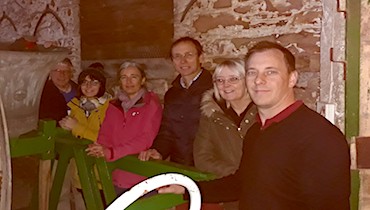M2F: 2 November 2019 - Tiverton
Five students and a couple of helpers from Plymouth, West Dorset, West Somerset and locally found their way to Tiverton in atrocious wet weather. As most towers in the area lack sound control or a set of simulators, it was decided to hold the course at St Paul’s (8cwt 6) in the morning and at St Peter’s (25 cwt 8) in the afternoon to spread the load on local communities. The usual Module 2F programme was followed covering foundation skills exercises, teaching call changes, exploring Kaleidoscope works and introduction to covering and plain hunt. Each of the students was asked to deliver a “mini-teach” to the rest of the group at some point in the day.
An innovation for the programme was the use of tyre mufflers at St Peter’s for the first practical session in the afternoon (Kaleidoscope works). The mufflers allow the tower to offer extra rope time for individuals and small groups without disturbance to the neighbours. Their use allows learners to practise the physical and visual skills, but is not so effective at developing listening skills without the percussive sound of a normal bell strike. The students were interested in trying out the mufflers and the picture shows the group inspecting them in the bell chamber after the session.
Everyone enjoyed the day despite the wet weather and were enthusiastic in their feedback at the end:
“Very good day, very helpful and informative instructor(s). Good facilities (Towers, kitchen & loos)”
“Good to see where one is, what one can contribute, what might be next … Thank you.”
“Extremely useful day; good use of ideas and exercises for band to try. Good use of learning materials. Lovely bells to ring. Networking with other like-minded ringers. Thanks, Les & Co.”
“Good to be able to put skills into practice straightaway, meet new ringers and enter an open discussion about what we find helpful as individuals. Great bells at Tiverton. Thank you!”
“Very good and interactive. Thanks.”
Les Boyce

Course Tutor: Les Boyce

Teaching from Rounds to Plain Hunt
Learn how to teach build really good foundation ringing skills in your ringers.
» Find out more about Module 2F